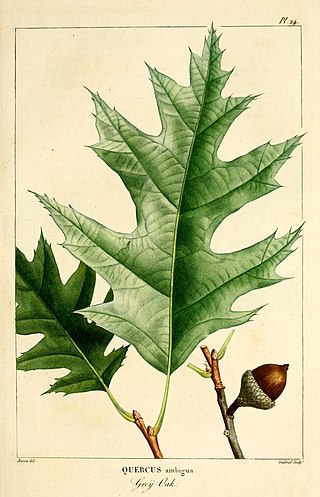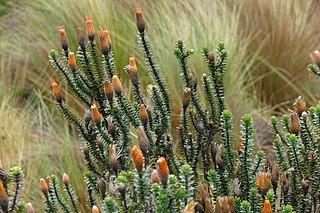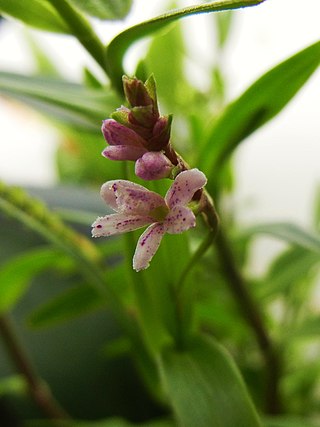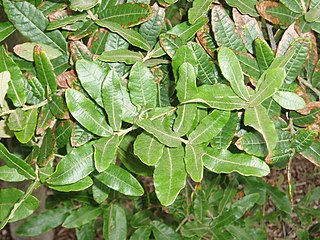
Aimé Jacques Alexandre Bonpland was a French explorer and botanist who traveled with Alexander von Humboldt in Latin America from 1799 to 1804. He co-authored volumes of the scientific results of their expedition.
Harold Ernest Robinson was an American botanist and entomologist.

Quercus diversifolia is an uncommon North American species of oak native to Mexico. It has been found in the states of Nuevo León, Durango, México, and Puebla.

Chuquiraga is a genus of flowering plants in the family Asteraceae. The genus is distributed in the Andes from Colombia to Chile, with most species occurring in Patagonia.
Machaonia is a genus of flowering plants in the family Rubiaceae. It has about 32 species. All are indigenous to the neotropics. None has a unique common name. Some species have been called "alfilerillo", a Spanish name for the common and well-known genus Erodium. The type species for Machaonia is Machaonia acuminata.

Quercus xalapensis, or xalapa oak, is a species of oak in the red oak group. It is native to the mountains of eastern and southern Mexico, as well as Guatemala, Honduras, and Nicaragua in northern Central America.

Guardiola is a genus of plants in the family Asteraceae, native to Mexico and the southwestern United States. Members of the genus are subshrubs with simple, opposite leaves and terminal inflorescences.
Erato is a genus of flowering plants belonging to tribe Liabeae of the family Asteraceae. It is found from Costa Rica to Bolivia, with its main centre of diversity in Ecuador.

Trichospira is a genus of flowering plants in the tribe Vernonieae within the family Asteraceae.
Chrysactinium is a genus of South American flowering plants in the family Asteraceae.

Epidendrum fimbriatum is a terrestrial orchid native to high altitudes (2.2—3.4 km) in Bolivia, Colombia, Ecuador, Peru, and Venezuela.

Quercus humboldtii, commonly known as the Andean oak, Colombian oak or roble, is a species of oak found only in Colombia and Panamá. It is named for Alexander von Humboldt.

Limnocharis is a genus of plants in the family Alismataceae, native to Mexico, Central America, the West Indies and South America) but naturalized in China, India, and Southeast Asia as well. Two species are recognized as of May 2014:
Guynesomia is a genus of Chilean flowering plants in the tribe Astereae within the family Asteraceae.
Tagetes zypaquirensis is a Latin American species of marigold in the family Asteraceae. It has been found in Central America, Colombia, and Ecuador.

Quercus crassifolia is a species of oak. It is widespread in Mexico from Sonora and Chihuahua to Veracruz and Chiapas. It has also been found in Guatemala.

Quercus obtusata is an oak in the white oak group endemic to Mexico, with a distribution ranging from San Luis Potosí and Nayarit south to Oaxaca, from 620 to 2800 MSL.

Quercus crassipes is a species of oak tree. It is widespread across much of Mexico from Sonora and Hidalgo south to Chiapas.
Quercus mexicana is a species of oak. It is widespread in eastern Mexico from Chiapas to Tamaulipas.

Chaetogastra mollis is a species of flowering plant in the family Melastomataceae, native to western South America. It was first described by Aimé Bonpland as Rhexia mollis in part of Monographia Melastomacearum, volume 2, published in 1808. Its synonyms include Tibouchina mollis.












